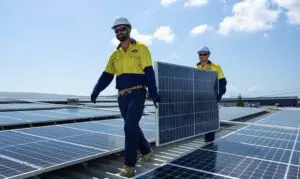Some of the biggest players in Australia’s wind energy industry have called on the Victorian government to stick to the science – and the goal of limiting global warming to 1.5°C – as it prepares to set its first interim targets on the path to net-zero emissions by 2050, economy-wide.
Victoria, which leads Australian states with the nation’s first legislated target of 50 per cent renewables by 2030, is required by its Climate Change Act 2017 to set five-yearly interim emissions reduction targets to keep the state on track for its 2050 goal.
According to the Act, the first two interim targets – for 2025 and 2030 – are due to be determined by March 31, 2020 and the decision must be tabled in Parliament within 10 sitting days.
With one week of deliberation to go, a coalition of 10 companies and NGOs including including Acciona, Pacific Hydro, Windlab and Friends of the Earth, has called on the Labor Andrews government to continue to set a strong policy example at a crucial time for climate action.
“We believe the government can show leadership by setting science-based Emissions Reduction Targets that keep global warming below 1.5 degrees,” the joint statement says.
“The International Panel on Climate Change’s (IPCC) has said that this decade is critical and ambitious steps need to be taken. In 2018, the IPCC’s Special Report reinforced the huge risks if global warming rises above 1.5 degrees.”
The co-signatories, which also include Westwind Energy and Osmi Australia, argue that strong interim emissions reduction targets can build on the Victorian Renewable Energy Target, particularly at a time when any federal incentives for large-scale wind and solar have disappeared.
The Australian Wind Alliance, which helped to coordinate the petition, said wind energy was a mainstay of employment in Western Victoria, with more than 1500 construction jobs currently created around wind farms.
“Setting ambitious targets will help provide more regional jobs into the future and boost the economic health of regional communities while moving the state away from fossil fuels,” said Tony Goodfellow, AWA spokesperson.
The large-scale wind pipeline, alone, amounts to more than 8GW of zero-emissions electricity generation either committed or proposed to be built in Victoria, the statement said – and that is only onshore.
“Setting science-based Emissions Reduction Targets is the next logical step … and would allow Victoria to build on the momentum and kickstart a jobs-rich offshore wind energy industry,” said Pat Simons from Friends of the Earth in Victoria, which led the community campaign for the VRET.
“The South Gippsland coast has been identified as the best place to build the country’s first offshore wind farm Star of the South. Targets that are bold and ambitious will send a signal to investors that Victoria is ready to kickstart this new, jobs-rich industry,” Simons said.
Westwind, which is the developer behind the massive Golden Plains wind farm near Ballarat, said successful emissions reduction in Victoria was closely tied to the success of the renewable energy industry in the state.
“Renewable energy projects, including wind, solar and pumped hydro projects are ready to play their role in drastically cutting emissions from the electricity sector,” said Westwind managing director Tobi Geiger.
“We have just experienced one of the most difficult summers in living memory; drought, fires, and multiple record setting extreme weather events. This has resulted from a 1.1 degrees of global warming,” added Roger Price, the CEO of Windlab.
“We can and must act. We have the technology within the electricity sector to be near zero emissions in less than 15 years. Victoria has been one of the leaders and we need them to remain courageous and bold by committing to 1.5°C Emissions Reduction Targets.”
[pdf-embedder url=”https://reneweconomy.wpengine.com/wp-content/uploads/2020/03/Joint-Statement_-RE-companies_ERTs_EMBARGOED-24032020.pdf” title=”Joint Statement_ RE companies_ERTs_EMBARGOED 24032020″]









